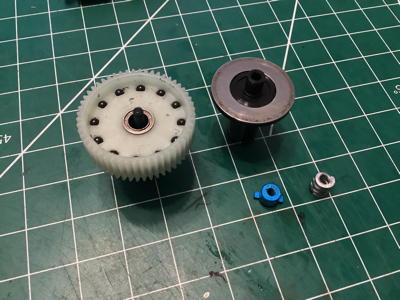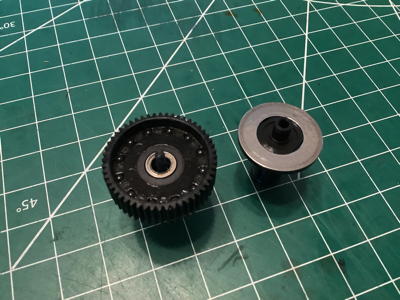Tamiya FF-03 Project
Page 1: FF-03 Standard, PRO, and R
While documenting this build project, I am going to compare the basic
FF-03 chassis, FF-03 PRO, and the more upgraded FF-03 R. All
share a great deal in common. I probably had the parts available
to build each separately in sequence, but it made more sense just to
compare them as I went along.
The basic FF-03 and PRO both came with a ball differential using the white gear set 51416 from the TRF 201. The black gear set is a glass reinforced upgrade (54262) that came with my upgraded model purchase.
The FF-03 R uses a sealed gear differential from the TA-06
instead of the ball differential discussed above. The width of the gear differential is greater than that
of the ball differential so a wider gearbox housing is required.
The original housing (9005979)
is shown below the wider R housing (9008152), each of which comprise a
different A parts tree. Look in particular at the large opening
for the drive cups and see how the upper housings have a deeper
boss. Almost all of the plastics on the R are carbon reinforced including the gearbox housing.
Here an original ball differential is being installed into the 3 gear
transmission housing. The input counter gear is metal. All
versions of the FF-03 use full ball bearings.
The standard FF-03 uses a simple stamped metal motor mount while the PRO
and the R use a more complex machined aluminum mount with heat sink
slots milled into it. Since I don't have a standard FF-03 I can't take a photo for comparison.
The motor sits ahead of the front axle on
the FF-03.
The plastic dual bellcrank steering is the same on all 3 chassis
variants and all use metal bushings rather than bearings on the
pivots. The blue aluminum pivot balls are from the R. The stainless hex hardware shown is an
upgrade that came with my model purchase. The kits came with JIS screws.
Here the steering is installed into the chassis. The plastic
bathtub chassis is common to all 3 variants. Although the R uses a
lot of carbon reinforced plastics, the deck is not among them probably
because it would be too brittle. The standard FF-03 used steel
turnbuckles. The blue aluminum versions shown came with the PRO
and R.
Now to build the inboard front suspension system. The bridge parts
(K parts tree) are carbon reinforced on the R. The blue pivot
balls are also from the R. The layout is the same on all 3 variants.
Now the suspension bridge can be attached to the chassis. This
step covers and retains the steering posts as well. The lower
suspension arms (D parts tree) are carbon reinforced on the R. The
standard FF-03 and the PRO use plastic suspension blocks while the R
uses machined aluminum versions. The plastic versions are shown
here. This system of mix-and-match suspension blocks to control
toe angle originally came from the TRF 415. The reversible
suspension arms originally came from the TRF 417.
Now the front bumper support and the spur gear have been
installed. All 3 variants use the same 68T spur gear. The
blue aluminum spur gear mount shown is only used on the R. The
carbon reinforced C-hubs and knuckles (C and F parts trees) are also
unique to the R. The R uses the clamping aluminum hexes shown
while the standard FF-03 and the PRO use plastic parts. The
knuckles and uprights originally came from the TRF 416. The
standard FF-03 and PRO use dog bone axles while the R uses CVD type
axles from the TRF 417.
The standard FF-03 uses plastic CVA shocks, but both the PRO and the R
use aluminum TRF shocks as shown. I never get tired of building
TRF shocks.
Now we can start on the rear suspension which looks very odd with no
gearbox. The rear suspension mount can be built 3 different ways
to support different wheelbases (233mm, 245mm, 257mm).
The shock tower, bulkhead, and supports (M parts tree) and rear uprights
(E parts tree) are carbon reinforced on the R. The front and rear
shocks use different springs (yellow band medium rate on rear, blue
band hard rate on front). The rear suspension is built up as a complete module as shown.
The finishing touches are the servo mount and battery stay. The
battery stay doubles as an upper deck and stiffens the chassis. It
is plastic (as shown) on the standard FF-03 and PRO, but carbon on the
R.
©2023 Eric Albrecht

